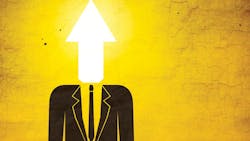Manufacturing companies are frequently born out of innovation, and Nest is no exception. After Tony Fadell left Apple (IW 500/9), he began building a new home and stocking it with leading-edge, energy-efficient features. Innovative products abounded, except, he found, when it came to thermostats. He began discussing this with Matt Rogers, who had also recently left Apple. They spent more than six months investigating thermostats and decided that with 10% of all U.S. energy consumed heating and cooling homes, the product was ripe for innovation.
See Also: Manufacturing Innovation & Product Development Strategy
"We saw the opportunity and we had to do it," Rogers, the co-founder and vice president of engineering, says.
Since launching the thermostat, Nest has constantly upgraded the product by issuing 17 software updates. That’s not the only innovative aspect of Nest’s approach to the market. The company keeps in regular communication with customers through a monthly energy report that tells them not only how much energy they saved individually and what they can do to save more energy, but also what the cumulative savings of Nest’s installed base have been.
"This is a product that often can be set-and-forget, but by having this ongoing communication, it is no longer set-and-forget. It is actually very engaging," says Rogers.
Fadell and Rogers might be thought to have a leg up on leading innovation, coming out of a corporate culture at Apple, says Rogers, which was "incredibly hungry and incredibly aggressive and never satisfied."
But the obsession with innovation is not confined to consumer electronics companies. Larry Keeley, an innovation expert at Deloitte, says he has seen "broad growth" in attention to innovation and chalks up a good deal of the CEO fixation on innovation to "Steve Jobs jealousy." He says it is routinely the "number one, two or three CEO personal agenda item."
Why all the concern in executive circles?
"If you run your business well, you’ve stripped out extraneous costs, you’ve hived off all the nonessential functions, figured out how to be super efficient, you still find that your category is heavily contested. The talent doesn’t necessarily want to come work for you. The customers you’re serving want to out-negotiate you every chance they get -- unless or until you have something that breaks out and gets its unfair share of attention," Keeley observes.
Innovation Extra: "The Church of the Game Changer"
Even for a company as revered as Apple, concerns about innovation can quickly batter its reputation and its stock price. Apple stock hit $705 last September but has recently traded as low as $385 as concerns fester that the Apple innovation pipeline is not flowing smoothly.
"The ongoing risk in the Apple story continues to be whether the company can innovate at the same pace and with the same intensity that occurred during the Steve Jobs era. The price action of the stock suggests that the market does not believe it can," says Needham Research.
The truth is that most companies are bedeviled by problems developing innovative products and services. In his new book, "Ten Types of Innovation" (John Wiley & Sons), Keeley cites research his firm, Doblin (now part of Deloitte), did several years ago that found 95% of innovation efforts in manufacturing and services fail. In Keeley’s view, the way to improve those outcomes is to focus on the process, the "tradecraft" of innovation.
No Lack of Ideas
When Keeley meets with company leaders, he frequently hears that the problem with their innovation efforts is "our people just aren’t creative enough." But that, he insists, is never the problem with innovation effectiveness.
"All firms have more ideas than resources to pursue them," says Keeley. "They have no robust way to get the boldest of their ideas to persist all the way through the filters and behavioral obstacles that are in the enterprise’s way."
In "Ten Types of Innovation," Keeley draws on more than 30 years of research to identify the practices that would lead to higher rates of success with innovation. Keeley identifies 10 different areas for innovation:
- Profit Model
- Network
- Structure
- Process
- Product Performance
- Product System
- Service
- Channel
- Brand
- Customer Engagement
By understanding these innovation types, he says, company leaders can diagnose patterns of innovation within industries, identify innovation opportunities, and evaluate how well their company is performing at innovation compared to their competitors.
Keeley urges companies not to rely simply on incremental improvements to their core business, but to look for opportunities to "complement those developments with bolder, transformational innovations that open up new markets and provide growth opportunities." He cautions against relying on product innovation alone, because new products "are fairly easy to copy, which allows competitors to catch up quickly."
Nest’s Rogers echoes the need for boldness, saying the most important lesson he took away from Apple is "not to be afraid to replace yourself." He points to the company’s transition from the iPod to the iPhone. In 2006-07, the iPod accounted for half the revenue of the company. Yet, Apple’s leaders knew that it would soon face competition from all-in-one devices.
"We had to beat ourselves to it," said Rogers. "That led to the iPhone that we all know and love today. A lot of companies wouldn’t have done it. To build a product that cannibalizes your own sales is very hard to do."
Providing the Right Model
Of the obstacles innovation faces in companies, perhaps none is bigger than leadership itself. While it is human nature to be resistant to change, company leaders who resist new ideas can easily lead their companies on a path to destruction. They can also provide too little guidance to their team on what initiatives to pursue.
Keeley recommends that company leaders draft an "Innovation Intent" -- a statement that creates a "vivid goal" for employees to pursue. A prime example, he writes in "Ten Types of Innovation," was President Kennedy’s 1961 call to land a man on the moon by the end of the decade.
Leaders need to be curious and open to new ideas and to respect the talents of the people in their organization, says Cynthia Ridley, a consultant with innovation consulting firm Kalypso.
"When you bring someone in for their ideas and thinking and the leader above them has a closed mindset, you diminish that person’s contribution," she warns. "Not only do you miss the opportunity that would have come from those ideas, but those people start shutting down."
One of the problems, Ridley says, is that a culture that does not support innovation can easily harbor managers who suppress new ideas. "Day to day, those innovative ideas get squelched," she says. "It happens in the middle of the organization where executives never know a great idea was shut down. It never surfaced."
To help ensure success with innovation, companies should have a strong focus on their customers, says Ridley. Companies can become mired in infighting or focusing on ways to honor their founders rather than keeping their efforts directed at helping customers, she says.
Customer focus is at the core of a cultural transformation that Ashish Kulkarni is leading at Celanese Corp. (IW 500/152), a $6.4 billion chemicals firm based in Dallas. Kulkarni, Celanese’s chief technology and innovation officer, says whatever activity Celanese employees are engaged in, some aspect of it should be linked to serving customers.
While some companies rise on the ideas of innovative leaders, it may be far more important for leaders to serve as "multipliers," says Ridley, referencing the book of that title by Liz Wiseman. Ridley says these leaders don’t have to be the smartest person in the room, but rather ask brilliant questions and challenge their people.
"It is getting people to let go of that ego place of owning an idea and having to have it be right. I am sharing my idea, but I’m not attached to it," says Ridley. "It is a whole different dynamic."
Along with encouraging ideas, company leaders need to ensure that they create an environment that tolerates "smart mistakes," says James Cusumano, who left a successful career as a research scientist at Exxon (IW 500/1) to help found Catalytica in 1974. The firm, which uses molecular engineering to design catalysts, eventually grew into a $1 billion public company with divisions in clean energy and pharmaceuticals.
Cusumano, author of "Balance: The Business-Life Connection" (SelectBooks), points to a host of successful products such as Teflon, Post-It notes and Viagra that developed out of research efforts that were initially deemed failures.
"There must be a tremendous amount of trust in the organization," says Cusumano. "There can’t be a fear of failure or of retribution. Employees all the way through the organization need to say, 'This is a fair organization. They are really interested in innovation and have a passion for it.’"
Just as importantly, says Cusumano, companies need to be sure to reward innovation. "The most difficult thing is to do it fairly. My definition of innovation means you take something new to marketplace and get a return. Usually in a manufacturing company, it is a financial return. How do you then decide who gets a piece of the pie? We did it by interviewing a lot of people on the teams. As the company gets larger, the innovation can be spread over a number of people, so you have to do your damnedest to reward people fairly."
While leaders should value innovators, says Ridley, that doesn’t mean that other roles in a manufacturing organization are any less important. She says some people are born to be innovators, but company leaders must surround them with people who can turn those ideas into reality.
"There are always going to be people who are more comfortable delivering the day-to-day operations and they are great at that," says Ridley. "They are not comfortable with uncertainty or risk, or creating structure out of risk. That’s okay."
About the Author
Steve Minter
Steve Minter, Executive Editor
Focus: Leadership, Global Economy, Energy
Call: 216-931-9281
Follow on Twitter: @SgMinterIW
An award-winning editor, Executive Editor Steve Minter covers leadership, global economic and trade issues and energy, tackling subject matter ranging from CEO profiles and leadership theories to economic trends and energy policy. As well, he supervises content development for editorial products including the magazine, IndustryWeek.com, research and information products, and conferences.
Before joining the IW staff, Steve was publisher and editorial director of Penton Media’s EHS Today, where he was instrumental in the development of the Champions of Safety and America’s Safest Companies recognition programs.
Steve received his B.A. in English from Oberlin College. He is married and has two adult children.


